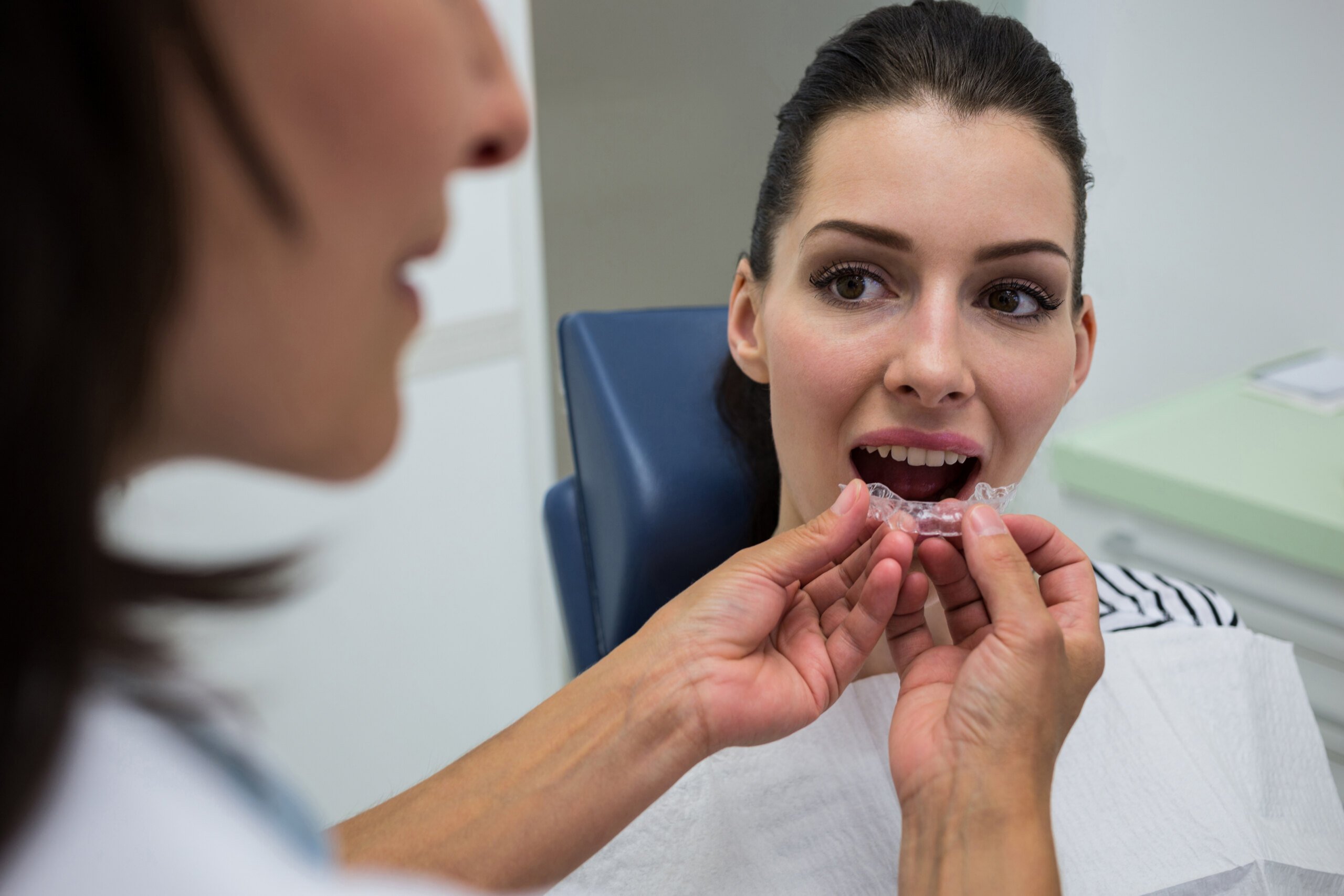Tired of waking up with aching jaws and headaches? Bruxism, or teeth grinding, can lead to significant discomfort and oral damage. Fortunately, there is a non-invasive and effective solution available, which is occlusal guards! These guards can alleviate jaw pain, headaches, and the wear and tear on teeth caused by bruxism.
What’s more, they are user-friendly and easy to maintain. Constructed from durable processed acrylic resin, the occlusal guard is a robust and inflexible device capable of withstanding nightly use. Bid farewell to bruxism-induced discomfort and say your regards to peaceful nights with the help of occlusal splints.
TYPES OF OCCLUSAL SPLINTS
There are various types of occlusal splints designed to address different aspects of temporomandibular joint disorder (TMD) and related conditions.
1. ANTERIOR REPOSITIONING SPLINTS:
These splints are specifically crafted to treat TMD. Their primary function is to reposition the jaw, thereby alleviating stress on the temporomandibular joint (TMJ). By guiding the lower jaw into a more favorable position, anterior repositioning splints aim to find a more comfortable and less stress-inducing alignment for the jaw.
2. POSTERIOR BITE PLANE SPLINTS:
These splints are designed to prevent the posterior (back) teeth from making contact during chewing or clenching, effectively reducing the chances of grinding and clenching. By maintaining a separation between the back teeth, posterior bite splints aim to minimize the forces exerted on the TMJ during activities like chewing.
3. NEUROMUSCULAR ORTHOTICS:
These specialized splints are employed for treating complex bite problems. They work towards harmonizing the alignment of teeth, muscles, and joints within the oral cavity. Neuromuscular orthotics seek to achieve a balanced and stable relationship between the jaw, muscles, and teeth.
This alignment contributes to a more comfortable and functional bite. The choice of occlusal splint depends on the specific requirements of each patient. A dentist, with their expertise and understanding of the individual’s condition, will recommend the most suitable type of splint for optimal therapeutic results.
This personalized approach ensures that the treatment aligns with the patient’s unique needs and addresses the particular challenges posed by their TMD or related condition.
MATERIALS OF OCCLUSAL SPLINTS
Occlusal splints are fabricated from various materials, each offering unique properties to cater to individual needs. These materials typically include polymethyl methacrylate (PMMA), available in forms such as powder and liquid sheets, and pre-polymerized blocks with options for transparent or opaque and tooth-colored finishes. Additionally, polyethylene terephthalate-glycol is utilized in the form of foils, with choices between transparent or colored variations.
Ethylene-vinyl acetate (EVA) is employed in foil form, also offering transparency or a range of colors. Furthermore, polyolefin is used in foil form for occlusal splints.
The availability of a variety of materials for medical practitioners to choose from offers them a broad range of options that can effectively cater to specific clinical needs and individual patient preferences. This diverse selection of materials can ensure that practitioners have the necessary tools to provide the best possible treatment for their patients and achieve optimal clinical results.
WHO NEEDS AN OCCLUSAL SPLINT?
Grinding and clenching of teeth can lead to various dental issues, including worn or chipped teeth as well as jaw discomfort. While a standard occlusal guard proves beneficial for many individuals, it may not be the optimal solution for everyone struggling with teeth-grinding issues.
For individuals with severe bruxism or temporomandibular joint disorder (TMD), an occlusal splint often proves to be the most effective remedy. This custom-made appliance, typically crafted from acrylic, fits snugly over the teeth to deter grinding and clenching, primarily during sleep.
By positioning the jaw in a way that alleviates strain on the muscles and joints, the splint safeguards against both muscle tension and dental damage. It is crucial to collaborate with a dentist or dental specialist who can thoroughly evaluate your condition and create the most suitable treatment plan for your needs.
HOW DO OCCLUSAL GUARDS WORK?
An occlusal guard acts as a protective barrier between the upper and lower teeth, effectively preventing the consequences of tooth grinding. Furthermore, it allows the jaw muscles to ease into a state of relaxation, alleviating tension and minimizing any discomfort or soreness in the jaw muscles. This dual function not only safeguards against dental damage but also promotes overall comfort in the jaw area. The main goal of the occlusal guard is to:
- Prevent additional tooth damage and gum recession
- Prevent wear on the surface of the teeth
- Relax the jaw
- Protect the jaw from joint problems
- Prevent headaches, earaches, and toothaches
- Promote healthy sleep patterns
While occlusal guards cannot cure the problem of bruxism or TMJ, once you have developed them, they can effectively reduce your symptoms while protecting you from further damage caused by long-term tooth grinding.
INSTRUCTIONS FOR WEARING AN OCCLUSAL GUARD
For optimal results, it is advised to wear your night guard consistently for a period of 4 to 6 weeks to get used to its nightly use. This adjustment period is crucial for achieving quick pain relief. If, however, your occlusal guard or splint induces discomfort, it may indicate an improper fit.
In such cases, obtaining a new impression of your teeth or consulting your dentist for necessary adjustments is recommended. It’s worth noting that building a permanent habit typically takes several weeks. This makes this timeframe a reasonable period for wearing your occlusal guard before considering alternative treatment options.
ENDING NOTE
Sleep bruxism, the habit of grinding or clenching teeth while asleep, can cause serious damage to teeth and lead to other health problems. One effective way to manage this condition is by using occlusal splints, also known as night guards. These devices work by providing a cushioning barrier that prevents teeth from grinding against each other during sleep.
Occlusal splints can be custom-made at a dentist’s office or purchased over the counter (OTC). Custom-made splints offer a more precise fit, while OTC options provide a more affordable solution. Regardless of the type, occlusal splints serve as a practical and effective solution for protecting dental health, reducing pain and discomfort, and promoting restful sleep.













